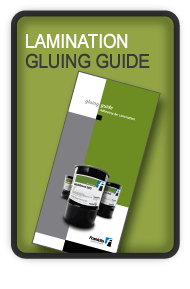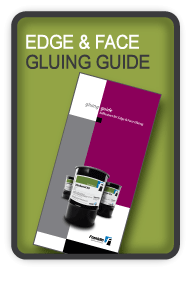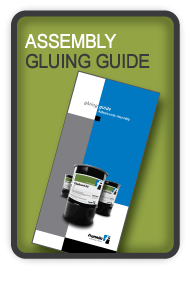Click here to download our brochure on ASTM standards
Cold Press Laminating | Hot Press Laminating | Radio Frequency Edge Gluing | Edge & Face Gluing | Assembly Gluing

Cold Press Laminating
Total delamination with little or no substrate failure
Possible Causes:
Pre-cure (no glue transfer)
Recommendation: Increase glue spread
Low pressure (poor contact)
Recommendation: Increase pressure
Short press time
Recommendation: Increase pressure period
Spotty bond
Possible Causes:
Uneven surfaces
Recommendation: Calibrate cores to uniform thickness and/or increase pressure
Worn Spreader Rolls
Recommendation: Replace or re-groove rolls
Glue bleeds through face veneers
Possible Causes:
Excessive glue spread
Recommendation: Reduce glue spread
Excessive pressure
Recommendation: Reduce pressure
Wrong adhesive type
Recommendation: Please contact our technical support team
Telegraphing of core defects or banding
Possible Causes:
Excessive pressure
Recommendation: Reduce pressure
Uneven or variable thickness
Recommendation: Re-sand core
Foreign material on core
Recommendation: Pre-clean core
Warpage of panels
Possible Causes:
Excessive or unequal spread
Recommendation: Reduce spread, and make sure spread is equal on both sides
Unbalanced construction
Recommendation: Check grain orientation and number of plies
Excessive moisture
Recommendation: 6-8% moisture content recommended
Brilliant white on glue squeeze-out and/or glue line
Possible Causes:
Chalking caused by low temperature
Recommendation: Raise temperature of plant, wood and adhesive above minimum use temperature of adhesive
Hot Press Laminating
Spotty bonds
Possible Causes:
Low spread
Recommendation: Increase adhesive spread
Uneven core thickness
Recommendation: Calibrate cores to uniform thickness
Low pressure
Recommendation: Increase pressure
Cold spots in platen
Recommendation: Check temperature with surface thermometer
Glue bleeds through face veneers
Possible Causes:
Excessive spread
Recommendation: Reduce adhesive spread
Excessive pressure
Recommendation: Reduce pressure
Wrong adhesive type
Recommendation: Please contact technical support
Steam blisters
Possible Causes:
Excessive spread
Recommendation: Reduce adhesive spread
High moisture content
Recommendation: 6%-8% moisture content recommended
High press temperature
Recommendation: Reduce temperature
Warpage of panels
Possible Causes:
Excessive spread
Recommendation: Reduce adhesive spread
Unequal spread
Recommendation: Make sure that top and bottom spread are equal.
High moisture content
Recommendation: 6%-8% moisture content recommended
Unbalanced construction
Recommendation: Check grain orientation
High press temperature
Recommendation: Reduce platen temperature
Checking of Veneer
Moisture content of the veneer and substrate are not equal
Recommendation: Select well-manufactured, tight-cut veneer, keep face veneer within 6% at time of pressing; core components and cross band materials should be held at about the same moisture content as the face veneer; keep assembly time to a minimum.
Radio Frequency Edge Gluing
Undercured joint/glue line still wet
Possible Causes:
Low power
Recommendation: Increase power
Short cure cycle
Recommendation: Increase cycle time
No pressure
Recommendation: Check filler boards and pressure system
High moisture content
Recommendation: 6-8% moisture content recommended
Improper catalyst mix
Recommendation: Please contact technical support
Generator malfunction
Recommendation: Contact equipment repair company
Cured joint-weak bonds
Possible Causes:
Slightly under-cured
Recommendation: Check power and time settings
Incorrect pressure
Recommendation: Check edge pressure
Irregular or burnished surfaces
Recommendation: Check surface preparation
Improper moisture
Recommendation: 6-8% moisture content recommended
Panel open on ends
Possible Causes:
Poor stock preparation
Recommendation: Check quality of gluing surface/end fit
Pressure shoes overlapping on next panel
Recommendation: Check and correct if necessary
Shrinkage between time of surfacing and pressing
Recommendation: 6-8% moisture content, 30% minimum relative humidity and glue within 24 hours of preparation
Burning in joints
Possible Causes:
Power too high
Recommendation: Reduce power
Improper catalyst level
Recommendation: Please contact technical support
Surface irregularities
Recommendation: Check surface preparation
Excessive spread
Recommendation: Reduce glue spread
Long assembly time
Recommendation: Press within five minutes
High edge pressure
Recommendation: Reduce edge pressure
Black glue lines
Possible Causes:
Iron contamination in adhesive
Recommendation: Isolate and eliminate contact source of wet adhesive with iron or steel

Edge & Face Gluing
Weak joints with little or no wood failure
Possible Causes:
Poor stock machining
Recommendation: Check for mechanical malfunction, check adjustment of equipment and make sure blades are sharp
Burnished surfaces
Recommendation: Increase feed rate on moulder/jointer and sharpen or replace cutter blades
Undercured or frosted joints caused by low temperature
Recommendation: Raise plant and stock temperatures
Undercured or frosted joints caused by short clamp time
Recommendation: Increase clamp time
Undercured or frosted joints caused by high moisture content
Recommendation: 6-8% moisture content
Undercured or frosted joints caused by thick glue lines
Recommendation: Check part fit and/or increase clamp pressure
Splits and/or open joints on ends of panels
Possible Causes:
High Moisture Content
Recommendation: 6-8% moisture content recommended.
Dry conditions in plant
Recommendation: 30% minimum relative humidity; use end sealer
Wood failure only over part of surface
Possible Causes:
Uneven pressure applied to top or bottom only
Recommendation: Apply pressure to top and bottom equally
Uneven pressure due to improper clamp spacing
Recommendation: Apply pressure near ends and 8-12" apart
Uneven pressure due to poor machining
Recommendation: Make sure that surfaces are flat and square
Uneven glue application
Recommendation: Coverage must be even over entire surface
Weak joints with wood failure along glue line
Possible Causes:
Grit of abrasive too coarse
Recommendation: 60 grit or higher recommended
Dull saw blades
Recommendation: Sharpen blades
Black glue lines
Possible Causes:
Iron contamination in adhesive
Recommendation: Isolate and eliminate contact source of wet adhesive with iron or steel
Brilliant white on glue squeeze-out and/or glue line
Possible Causes:
"Chalking" caused by low temperatures
Recommendation: Raise temperature of plant, wood and temperature above minimum use temperature of adhesive

Assembly Gluing
Weak joint
Possible Causes:
Loose part fit
Recommendation: Part should fit snugly but not require undue assembly force
Joint design (dowels too short, etc.)
Recommendation: Redesign joint
Glue setting too quickly/too slowly
Recommendation: Please contact technical support
Insufficient glue coverage
Recommendation: Apply uniform coating of glue to all parts of joint
Burnished surfaces
Recommendation: Sharpen cutter blades
Overspray of finish on gluing surface
Recommendation: Remove finish before gluing
Undercured or frosted glue lines due to low temperature
Recommendation: Raise plant, wood, and adhesive temperature
Undercured or frosted glue lines due to short clamp time
Recommendation: Increase clamp time
High Moisture Content
Recommendation: 6-8% moisture content recommended
Black glue lines
Possible Causes:
Iron contamination in adhesive
Recommendation: Isolate and eliminate contact source of wet adhesive with iron or steel
Brilliant white on glue squeeze-out and/or glue line
Possible Causes:
"Chalking" caused by low temperature
Recommendation: Raise temperature of plant, wood and adhesive above minimum use temperature of adhesive